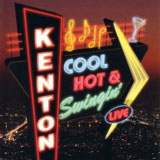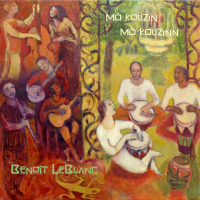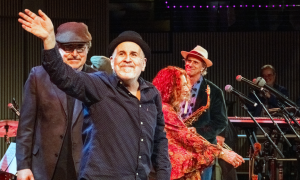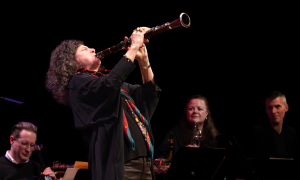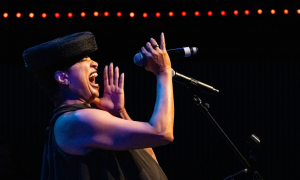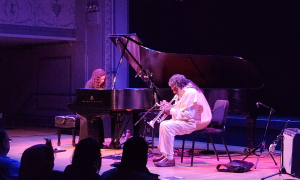Home » Jazz Articles » Live Review » 6th Rochester International Jazz Festival, Part 1
6th Rochester International Jazz Festival, Part 1
Rochester International Jazz Festival 2007—6th Edition
Rochester, New York
June 8-16 (Part 1)
Every year the Rochester International Jazz Festival becomes a little bigger and a little more unwieldy to cover. This year the tally was approximately 220 concerts in 18 venues—a real embarrassment of riches. Logistically, the concerts were still mostly all within a 3-block radius, with the addition of three new venues and the deletion of one—the Little Theatre, actually a nice small space with good sound but room for only 150 people. Promoters John Nugent and Marc Iacona were hoping for up to 100,000 visitors to the 9- day event this year. The final figure was over 120,000. Even apart from healthy attendance numbers, by all accounts this year's festival was a success.
Musicians seem especially to enjoy playing this festival and experiencing the vibe that engulfs the downtown area of this city with a population of 300,000. Frequently the artists can be seen walking along the streets, talking to people, eating in the various restaurants, shopping at the stores, etc. Many of them participate in the late night jam session at the Crowne Plaza Hotel. Overall, its a pleasant nine days spent in a city that has been struggling to regain its economic as well as its urban base over the past 20 years.
Musically the festival was a success as well. The free outdoor concert with Maceo Parker on the last Friday of the festival drew one of the biggest crowds ever at a street event. Every concert I attended, bar one, was a sell-out . Given a directive to cover what I wanted to, I tried to attend as many events as I could. As always seems to be the case, there were at least four highly promising concerts I had to pass up due to scheduling conflicts. But it's a good problem to have. Back in the 1980s/early 90s this city seemed to be a jazz-free zone with artists seemingly determined to bypass our fair city. It's been only since the late 90s, with an upgrade of the jazz faculty at the Eastman School of Music and the flag-waving avant- garde jazz shows at the Bop Shop and, more recently, weekly showcases of mainstream artists at the Strathallan, that this city has once again begun having a jazz music scene. One is now able to go out and hear live jazz on a regular basis. The RIJF tapped into these audiences, creating what is now a symbiotic relationship. As more people come to the jazz festival and are exposed to the music, the more likely they are to attend jazz shows throughout the year.
Geri Allen Trio
Kilbourn Hall
June 8, 2007
Geri Allen: piano; Kenny Davis: bass; Jimmy Cobb: drums.
For my kickoff set of the 6th RIJF, I chose Geri Allen's trio. She's coming off a fine album, and the promise of seeing Jimmy Cobb in action made it the obvious choice. It was her first time performing at the festival.
Allen delivered a set of tunes from her new album and a couple of surprises. Never the most radical of players, Allen is one of the most stylistically diverse of the current crop of mainstream players and one whose respect for pianists like Muhal Richard Abrams is as deep as her respect for Bud Powell. Her indebtedness to both was patently on display this evening. The set opened with Allen playing unaccompanied, a sweeping impressionistic interlude setting up what was to come.
Leading off with the opening tracks from her most recent recording, Timeless Portraits And Dreams, Davis and Cobb laid down a cooking base off of which Allen sprang her solos. The opening piece lasted around 15 minutes, eventually resolving into a beautiful rendition of Mal Waldron's "Soul Eyes." Allen seemed relaxed, poised enough to next attempt the convoluted contrapuntalism of Bird's "A Leu Cha, which the trio brought off with great aplomb. The interplay between Allen and Davis was particularly acute. "Unconditional Love was given a lengthy reading and had a beautiful wind-down at its conclusion. The group finished with a spirited dedication to Billie Holiday, "Our Lady, followed by a lively encore. What was best about the set was the pianist's willingness to expand the material far beyond the recorded versions. Allen's improvs were continually mutating and developing into unexpected areas with each chorus. And Davis and Cobb were with her no matter how stretched the material became.
Through it all was the overriding presence of drummer Jimmy Cobb adding a driving swing with subtle accenting throughout. He was the epitome of jazz festival cool with his baseball cap and suspenders, looking like he was doing nothing at all, belying the rhythmic storm he whipped up. It was a great set to launch this year's RIJF.
Fred Hersch Trio
Kilbourn Hall
June 10, 2007
Fred Hersch: piano; John Hebert: bass; Nasheet Waites: drums.
Fred Hersch became an instant Rochester favorite after performing here last fall in a solo context on the very same Kilbourn Hall stage where his trio assembled. So the audience greeted the trio warmly as they ambled on stage and dove into Cole Porter's "So In Love." The piece started slowly, rhapsodically, gradually picking up steam until Waites kicked it into double time, at which point the music exploded. From his Walt Whitman cycle, Hersch went into "At The Close Of The Day, which turned into a feature for Hebert, his sound filling the hall beautifully. As the set progressed, the music seemed to head further and further toward the fringes, taking in Monk's "Work and Ornette Coleman's "Forerunner." They took sufficient time to dissect each piece, taking a phrase or a rhythmic motif and exploring it in depth before moving on.
Waites could very well be the most complete drummer of his generation. For this trio, his drumming was subtle, never overwhelming, adding color and shading yet always pushing the music along. It's hard to believe this was the same musician who recently toured as a duo with Peter Brotzmann. He would employ a different style in another, pending set in the festival. (More about that later.)
The trio concluded with two Irving Berlin tunes: a highly abstracted version of "How Deep Is The Ocean and a version of "Change Partners full of tricky trio interplay. When brought back for an encore, the pianist did a lovely solo version of "Mood Indigo." It now became apparent that Hersch had programmed a complete set, taking the audience on a journey to the outer reaches before returning them safely in their seats with the familiar. It would prove one of the most satisfying sets of the festival.
Lotte Anker Trio
Lutheran Church Of The Reformation
June 10, 2007
Lotte Anker: alto sax, soprano sax, tenor sax; Craig Taborn: piano; Gerald Cleaver: drums
After Hersch's set, we high-tailed it two blocks to one of the new venues, the Lutheran Church Of The Reformation. It was here that all of the concerts in the Nordic Jazz Now series—a set of nine concerts featuring Scandinavian bands generally unknown to most listeners—were held. Initially, some were referring to the venue as the Nordic ghetto, but it proved one of the most pleasant festival sites with surprisingly good sound and surprisingly comfy pews. The only drawback was the absence of air-conditioning on several nights when the temperature got quite warm. But, as in all the concerts I attended, the music rose above any personal discomfort.
The first concert in the series by Anker was the one true representative of the avant-garde end of the spectrum at this festival. So among certain people, this was the show to see. The alto saxophonist was performing with two American musicians, pianist Craig Taborn and drummer Gerald Cleaver. Together they made uncompromising, beautiful music that filled the church with the probing sounds of free jazz.
The set started with Taborn pecking out a light staccato attack, etching nervous jittery lines in the upper reaches of the keyboard. Next Cleaver fell in. Anker picked up her soprano and soon the three were off, building a swirling intensity little by little. This is a trio that understands pacing, and Cleaver is the perfect drummer for this music. In the ensemble he functions as much as a colorist as the rhythmic component. Taborn's virtuosic piano was a joy to behold. He frequently jousted with Anker, each feeding lines off the other's playing. Anker showed her facility on all three saxophones, demonstrating she had a distinctive and individual voice on each. She tended to build her solos incrementally, working with Taborn at times to create contrapuntal textures, using the extended range of her instrument sparingly but effectively.
The church was packed for this performance (capacity was roughly 500 people). There was attrition between the first and second pieces, which was not surprising for music as unfamiliar and challenging this. But one had to give those who left points for at least giving the music a chance. As for those who stayed, they became privy to what was one of the finest sets of the festival.
Benny Golson Quartet
Harro East Ballroom
June 10, 2007
Benny Golson: tenor saxophone; Antonio Ciacca: piano; Dennis Irwin: bass; Mike Melito: drums.
After Anker, it was one more block north to the Harro East Ballroom to see tenor master and composer of many jazz standards, Benny Golson. We arrived just as the first set was ending with a rousing non-Golson standard, "Take The A Train." When Golson and his quartet took the stage for the second set, they wasted little time picking up where they left off. First tune was one of Golson's greatest compositions, "Whisper Not." Taken at mid-tempo, the composer-tenor saxophonist took a series of variations on the tune that made one realize he owned it. The set was varied, including a classic by an early Golson collaborator, trumpeter Clifford Brown ("Tiny Capers ), a newer tune by Golson ("Pierre's Moment ) and a popular standard.
After playing his own composition, the leader brought out his sidemen for individual turns. Ciacca, a fine Italian pianist who spices his bop pianistics with a slight left-of-center tinge, played an attractive original, "Nico's Song." Golson introduced veteran bassist Irwin's solo feature with "You didn't know it but this is the moment you've all been waiting for. Irwin then proceeded to sing, whistle and spin his bass to "There's No You." Mike Melito, a Rochester drummer, was the last-minute replacement for Golson's regular drummer. When one is looking for a bop-based drummer in Rochester, one needs to go no further than Melito. He propelled the music with finesse, and Golson featured him liberally, seemingly enjoying his playing.
The lengthy set (it ran about 75 minutes) ended with a killer version of Golson's "Stablemates." The loquacious leader was a great ranconteur between songs, including stories about the meaning of the title "Whisper Not and the genesis of "Stablemates. The one drawback to the entire set was the poor sound of the Harro East facility. The piano and bass were barely audible at times, and the sound in the hall was boomy. Minor annoyances aside, it was still an enjoyable set and a rare chance to hear this great jazz veteran in Rochester.
Tags
PREVIOUS / NEXT
Support All About Jazz
 All About Jazz has been a pillar of jazz since 1995, championing it as an art form and, more importantly, supporting the musicians who make it. Our enduring commitment has made "AAJ" one of the most culturally important websites of its kind, read by hundreds of thousands of fans, musicians and industry figures every month.
All About Jazz has been a pillar of jazz since 1995, championing it as an art form and, more importantly, supporting the musicians who make it. Our enduring commitment has made "AAJ" one of the most culturally important websites of its kind, read by hundreds of thousands of fans, musicians and industry figures every month.

